Middleton W.M. (ed.) Reference Data for Engineers: Radio, Electronics, Computer and Communications
Подождите немного. Документ загружается.

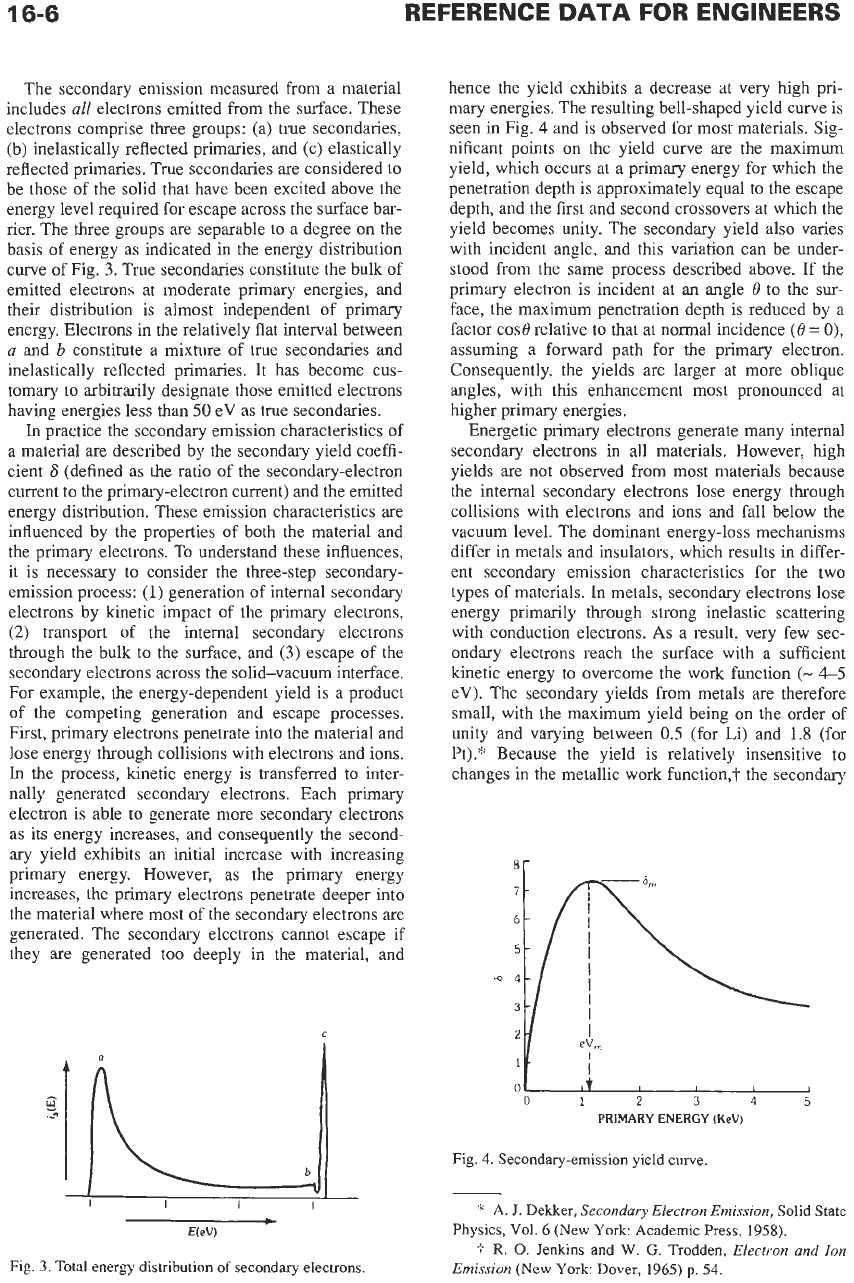
The secondary emission measured from a material
includes
all
electrons emitted from the surface. These
electrons comprise
three
groups: (a) true secondaries,
(b) inelastically reflected primaries, and (c) elastically
reflected primaries. True secondaries are considered to
be those of the solid that have been excited above the
energy level required for escape across the surface bar-
rier. The three groups
are
separable to a degree on the
basis of energy as indicated in the energy distribution
curve of Fig.
3.
True secondaries constitute the bulk of
emitted electrons at moderate primary energies, and
their distribution
is
almost independent
of
primary
energy. Electrons in the relatively flat interval between
a
and
b
constitute
a
mixture of true secondaries and
inelastically reflected primaries. It has become cus-
tomary
to
arbitrarily designate those emitted electrons
having energies less than
50
eV as true secondaries.
In
practice the secondary emission characteristics of
a material are described by the secondary yield coeffi-
cient
6
(defined as the ratio
of
the secondary-electron
current
to
the primary-electron current) and the emitted
energy distribution. These emission characteristics
are
influenced by the properties of both the material and
the primary electrons. To understand these influences,
it
is
necessary to consider the three-step secondary-
emission process:
(1)
generation of internal secondary
electrons by kinetic impact of the primary electrons,
(2)
transport of the internal secondary electrons
through the bulk to the surface, and
(3)
escape of the
secondary electrons across the solid-vacuum interface.
For example, the energy-dependent yield is a product
of the competing generation and escape processes.
First, primary electrons penetrate into the material and
lose energy through collisions with electrons and ions.
In
the process, kinetic energy is transferred
to
inter-
nally generated secondary electrons. Each primary
electron is able to generate more secondary electrons
as
its
energy increases, and consequently the second-
ary yield exhibits
an
initial increase with increasing
primary energy. However, as the primary energy
increases, the primary electrons penetrate deeper into
the material where most
of
the secondary electrons are
generated. The secondary electrons cannot escape if
they are generated
too
deeply in the material, and
hence the yield exhibits a decrease at very high pn-
mary energies. The resulting bell-shaped yield curve is
seen in Fig.
4
and is observed for most materials. Sig-
nificant points on the yield curve are the maximum
yield, which occurs at a primary energy for which the
penetration depth is approximately equal to the escape
depth, and the first and second crossovers at which the
yield becomes unity. The secondary yield also varies
with incident angle, and this variation can be under-
stood from the same process described above. If the
primary electron is incident at an angle
0
to the sur-
face, the maximum penetration depth is reduced by a
factor cos0 relative to that at
normal
incidence
(6
=
0),
assuming a forward path for the primary electron.
Consequently, the yields are larger at more oblique
angles, with this enhancement most pronounced at
higher primary energies.
Energetic primary electrons generate many internal
secondary electrons in all materials. However, high
yields are not observed from most materials because
the internal secondary electrons lose energy through
collisions with electrons and ions and fall below the
vacuum level. The dominant energy-loss mechanisms
differ in metals and insulators, which results in differ-
ent secondary emission characteristics for the two
types of materials. In metals, secondary electrons lose
energy primarily through strong inelastic scattering
with conduction electrons.
As
a result, very few sec-
ondary electrons reach the surface with a sufficient
kinetic energy to overcome the work function
(-
4-5
eV). The secondary yields from metals
are
therefore
small, with the maximum yield being on the order
of
unity and varying between
0.5
(for Li) and
1.8
(for
Pt).* Because the yield is relatively insensitive to
changes in the metallic work function,? the secondary
c
PRIMARY
ENERGY
(KeV)
Fig.
4.
Secondary-emission yield curve.
Fig.
3.
Total energy distribution
of
secondary electrons.
*
A.
J.
Dekker,
Secondary Electron Emission,
Solid State
T
R.
0.
Jenkins
and
W.
G.
Trodden,
Electron and Ion
Physics,
Vol.
6
(New York: Academic Press,
1958).
Emission
(New York: Dover,
1965)
p.
54.
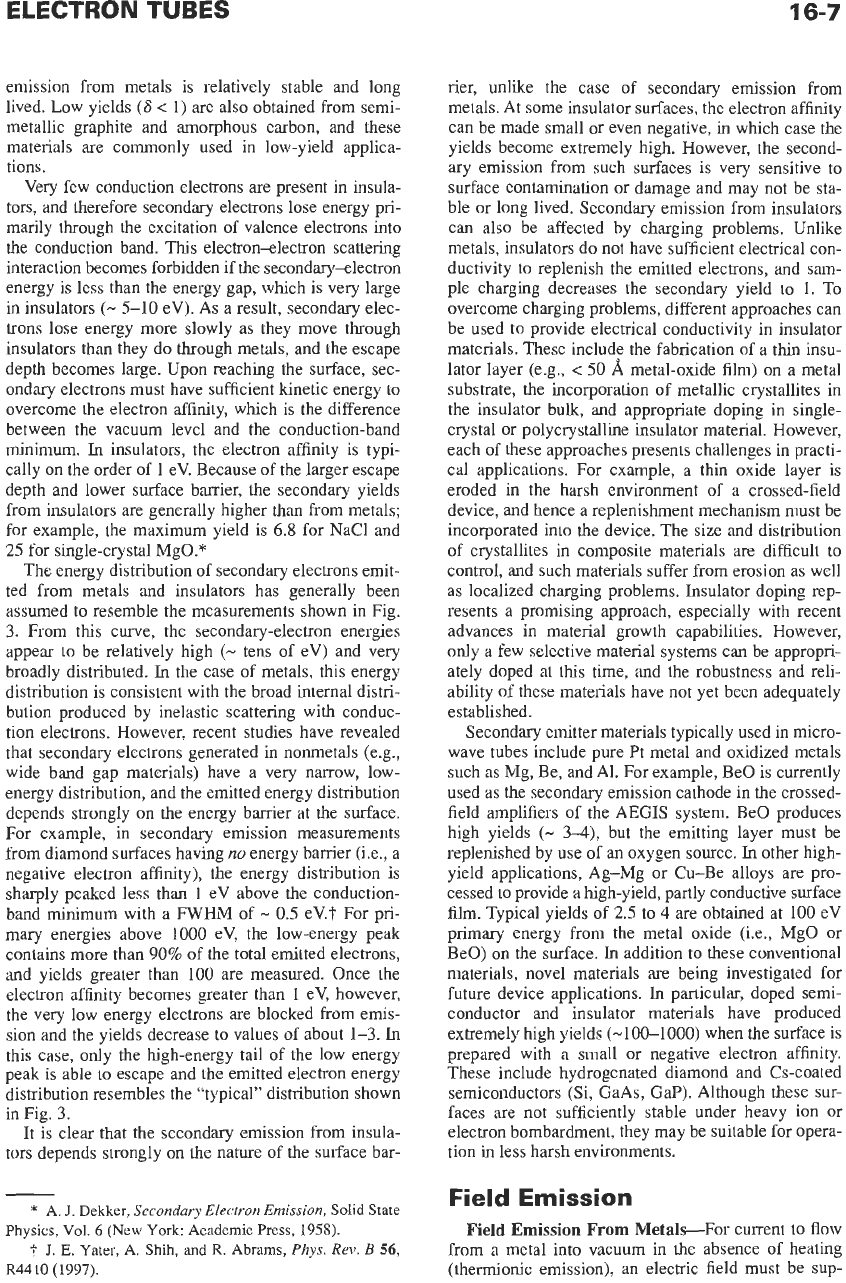
16-7
emission from metals is relatively stable and long
lived. Low yields
(6
<
1) are also obtained from semi-
metallic graphite and amorphous carbon, and these
materials are commonly used in low-yield applica-
tions.
Very few conduction electrons
are
present in insula-
tors, and therefore secondary electrons lose energy pri-
marily through the excitation of valence electrons into
the conduction band.
This
electron-electron scattering
interaction becomes forbidden if the secondary-electron
energy is less than the energy gap, which is very large
in insulators
(-
5-10
eV).
As
a result, secondary elec-
trons lose energy more slowly as they move through
insulators than they do through metals, and the escape
depth becomes large. Upon reaching the surface, sec-
ondary electrons must have sufficient kinetic energy to
overcome the electron affinity, which is the difference
between the vacuum level and the conduction-band
minimum.
In
insulators, the electron affinity is typi-
cally on the order of
1
eV. Because of the larger escape
depth and lower surface barrier, the secondary yields
from insulators are generally higher than from metals;
for example, the maximum yield is
6.8
for NaCl and
25
for single-crystal MgO.*
The energy distribution of secondary electrons emit-
ted from metals and insulators has generally been
assumed to resemble the measurements shown in Fig.
3.
From this curve, the secondary-electron energies
appear to be relatively high
(-
tens
of
eV) and very
broadly distributed.
In
the case
of
metals, this energy
distribution is consistent with the broad internal distri-
bution produced by inelastic scattering with conduc-
tion electrons. However, recent studies have revealed
that secondary electrons generated in nonmetals (e.g.,
wide band gap materials) have a very
narrow,
low-
energy distribution, and the emitted energy distribution
depends strongly
on
the energy barrier at the surface.
For example, in secondary emission measurements
from diamond surfaces having
no
energy barrier (Le., a
negative electron affinity), the energy distribution is
sharply peaked less than
1
eV above the conduction-
band minimum with a FWHM of
-
0.5
eV.t For pri-
mary energies above
1000
eV, the low-energy peak
contains more than
90%
of the total emitted electrons,
and yields greater than 100 are measured. Once the
electron affinity becomes greater than
1
eV, however,
the very low energy electrons are blocked from emis-
sion and the yields decrease to values
of
about
1-3.
In
this case, only the high-energy tail of the low energy
peak is able to escape and the emitted electron energy
distribution resembles the “typical” distribution shown
in Fig.
3.
It
is clear that the secondary emission from insula-
tors depends strongly on the nature
of
the surface bar-
*
A.
J.
Dekker,
Secondary
Electron
Emission,
Solid
State
t
J.
E.
Yater,
A. Shih,
and
R.
Abrams,
Phys.
Rev.
B
56,
Physics,
Vol.
6
(New
York:
Academic
Press,
1958).
R4410
(1997).
rier, unlike the case of secondary emission from
metals. At some insulator surfaces, the electron affinity
can be made small or even negative, in which case the
yields become extremely high. However, the second-
ary
emission from such surfaces is very sensitive to
surface contamination or damage and may not be sta-
ble or long lived. Secondary emission from insulators
can also be affected by charging problems. Unlike
metals, insulators do not have sufficient electrical con-
ductivity to replenish the emitted electrons, and sam-
ple charging decreases the secondary yield
to
1.
To
overcome charging problems, different approaches can
be used to provide electrical conductivity in insulator
materials. These includ: the fabrication of a thin insu-
lator layer (e.g.,
<
50
A
metal-oxide film) on a metal
substrate, the incorporation of metallic crystallites in
the insulator bulk, and appropriate doping in single-
crystal or polycrystalline insulator material. However,
each of these approaches presents challenges in practi-
cal applications. For example, a thin oxide layer is
eroded in the harsh environment of a crossed-field
device, and hence a replenishment mechanism must be
incorporated
into
the device. The size and distribution
of crystallites in composite materials are difficult to
control, and such materials suffer from erosion as well
as localized charging problems. Insulator doping rep-
resents a promising approach, especially with recent
advances in material growth capabilities. However,
only a few selective material systems can be appropri-
ately doped at this time, and the robustness and reli-
ability of these materials have not yet been adequately
established.
Secondary emitter materials typically used in micro-
wave tubes include pure
Pt
metal and oxidized metals
such as Mg, Be, and Al. For example, Be0 is currently
used as the secondary emission cathode in the crossed-
field amplifiers of the AEGIS system. Be0 produces
high yields
(-
3-4),
but the emitting layer must be
replenished by use
of
an oxygen source.
In
other high-
yield applications, Ag-Mg or Cu-Be alloys are pro-
cessed
to
provide a high-yield, partly conductive surface
film. Typical yields of
2.5
to
4
are obtained at 100 eV
primary energy from the metal oxide (Le., MgO or
BeO) on the surface.
In
addition to these conventional
materials, novel materials are being investigated for
future device applications.
In
particular, doped semi-
conductor and insulator materials have produced
extremely high yields (-100-1000) when the surface is
prepared with a small or negative electron affinity.
These include hydrogenated diamond and Cs-coated
semiconductors (Si, GaAs, GaP). Although these sur-
faces are not sufficiently stable under heavy
ion
or
electron bombardment, they may be suitable for opera-
tion in less harsh environments.
Field
Emission
Field Emission From Metals-For current to flow
from a metal into vacuum in the absence of heating
(thermionic emission), an electric field must be sup-
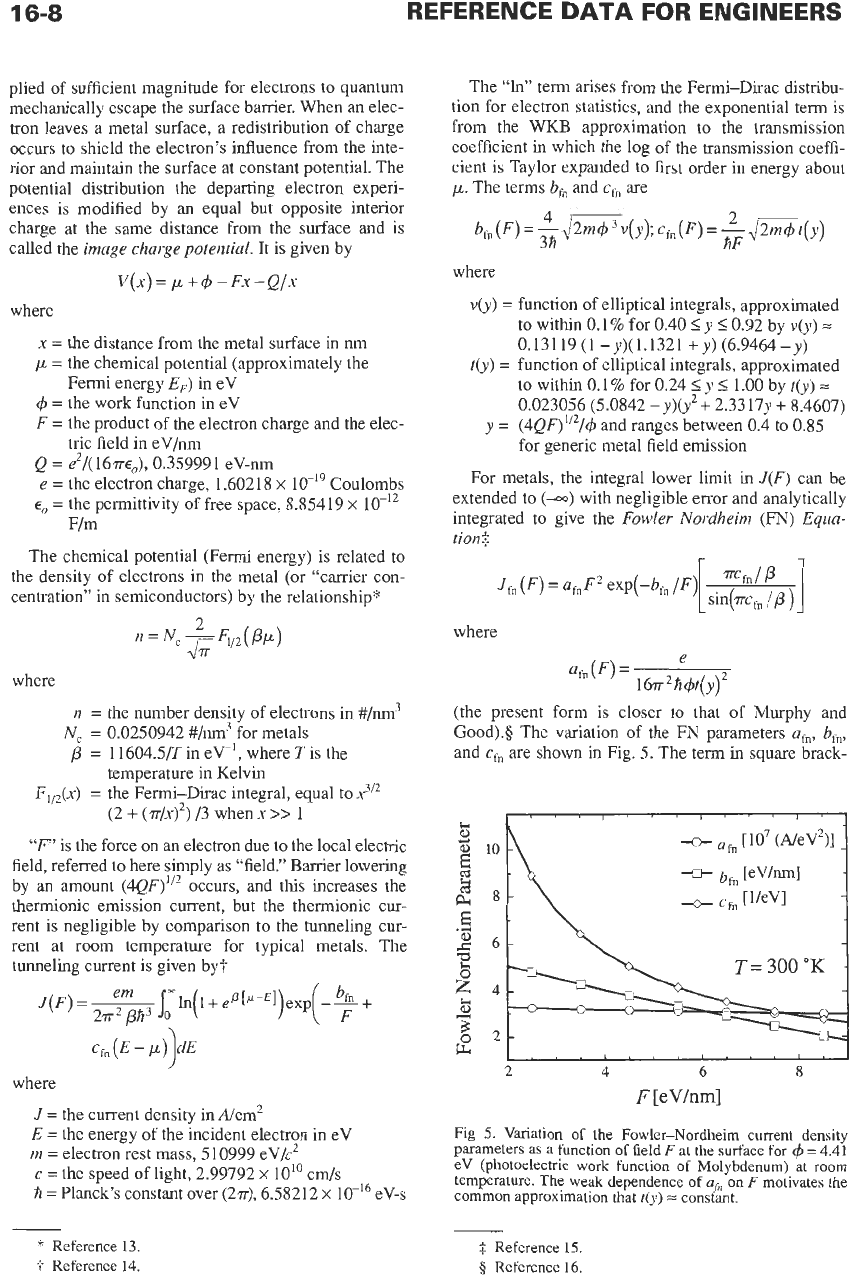
16-8
REFERENCE
DATA
FOR ENGINEERS
plied of sufficient magnitude for electrons to quantum
mechanically escape the surface barrier. When an elec-
tron leaves a metal surface, a redistribution of charge
occurs to shield the electron’s influence from the inte-
rior and maintain the surface at constant potential. The
potential distribution the departing electron experi-
ences is modified by an equal but opposite interior
charge at the same distance from the surface and is
called the
image charge potential.
It
is given by
V(X)
=
p
++
-
FX
-
Q/x
where
x
=
the distance from the metal surface in nm
p
=
the chemical potential (approximately the
Fermi energy
EF)
in eV
+
=
the work function in eV
F
=
the product of the electron charge and the elec-
tric field in eV/nm
Q
=
e2/(16m0), 0.359991
eV-nm
e
=
the electron charge,
1.60218
x
Coulombs
eo
=
the permittivity of free space,
8.85419
x
lo-’’
The chemical potential (Fermi energy)
is
related
to
the density of electrons in the metal (or “carrier con-
centration” in semiconductors) by the relationship*
F/m
where
n
=
the number density of electrons in
#/run3
N,
=
0.0250942
#/nm3
for metals
p
=
11604.5/T
in eV’, where Tis the
temperature in Kelvin
F1&)
=
the Fermi-Dirac integral, equal to
x3”
(2
+
(T/x)~)
/3
when
x
>>
1
“F”
is the force on
an
electron due to the local electric
field, referred to here simply as “field.” Barrier lowering
by an amount
(4QF)’”
occurs, and this increases the
thermionic emission current, but the thermionic cur-
rent is negligible by comparison to the tunneling cur-
rent at room temperature for typical metals. The
tunneling current is given by?
where
J
=
the current density in A/cm2
E
=
the energy of the incident electron in eV
m
=
electron rest mass,
510999
eV/c2
c
=
the speed of light,
2.99792
x
10”
cm/s
A
=Planck’s constant over
(27r), 6.58212
x
eV-s
The
“ln”
term arises from
the
Fermi-Dirac distribu-
tion for electron statistics, and the exponential term is
from the
WKB
approximation to the transmission
coefficient in which the log of the transmission coeffi-
cient is Taylor expanded to first order in energy about
p.
The terms
b,
and
cfn
are
where
v(y)
=
function of elliptical integrals, approximated
to within
0.1%
for
0.40
5
y
5
0.92
by
v(y)
=
0.13119 (1 -y)(1.1321 +y) (6.9464-y)
tb)
=
function of elliptical integrals, approximated
to within
0.1%
for
0.24
5
y
5
1.00
by
t(y)
=
0.023056 (5.0842
-y)(y’+
2.3317~
+
8.4607)
y
=
(4QF)’12/4
and ranges between
0.4
to
0.85
for generic metal field emission
For metals, the integral lower limit in
J(F)
can be
extended to
(a)
with negligible error and analytically
integrated to give the
Fowler Nordheim
(FN)
Equa-
tion$
r
where
(the present form is closer to that of Murphy and
Good).§ The variation of the
FN
parameters
ai,,
b,,
and
cfn
are shown in Fig.
5.
The term
in
square brack-
I
LL
I
2
4 6
8
F
[eV/nm]
Fig
5.
Variation of the Fowler-Nordheim current density
parameters as a function of field
F
at the surface for
q5
=
4.41
eV (photoelectric work function of Molybdenum) at room
temperature. The weak dependence
of
ai.
on
F
motivates the
common approximation that
f(y)
=
constant.
*
Reference
13.
t
Reference 14.
$
Reference 15.
5
Reference 16.
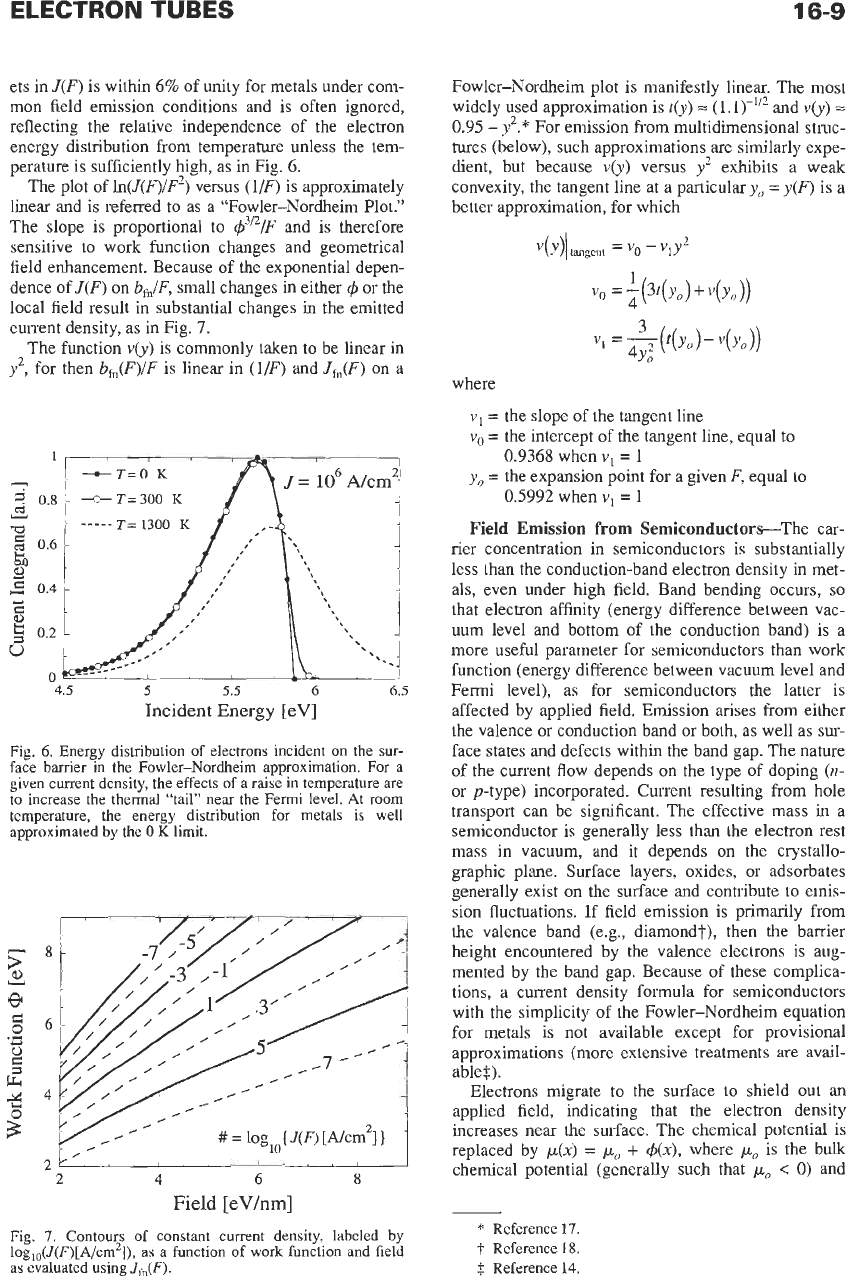
ELECTRON
TUBES
16-9
ets in
J(F)
is within
6%
of unity for metals under com-
mon field emission conditions and is often ignored,
reflecting the relative independence of the electron
energy distribution from temperature unless the tem-
perature is sufficiently high, as in Fig.
6.
The plot of
ln(J(F)/F2)
versus (1/F) is approximately
linear and is referred to
as
a “Fowler-Nordheim Plot.”
The slope is proportional to
43‘2/F
and is therefore
sensitive
to
work function changes and geometrical
field enhancement. Because of the exponential depen-
dence of
J(F)
on
b,/F,
small changes in either
4
or the
local field result in substantial changes in the emitted
current density, as in Fig.
7.
The function
v(y)
is commonly taken to be linear in
y2,
for then
b,(F)/F
is linear in
(1/F)
and
Jfn(F)
on
a
4.5
5
5.5
6
6.5
Incident Energy
[eV]
Fig.
6.
Energy distribution of electrons incident on the sur-
face barrier in
the
Fowler-Nordheim approximation. For a
given current density, the effects
of
a
raise
in temperature are
to
increase
the thermal “tail” near the Fermi level. At room
temperature,
the
energy distribution for metals is well
approximated by the
0
K
limit.
2k’
”
1
”
,
,,,,I
I
2
4
6
8
Field
[eV/nm]
Fig.
7.
Contours of constant current density, labeled by
log,,(J(F)[A/cm2]), as
a
function of work function and field
as evaluated using
Jm(F).
Fowler-Nordheim plot is manifestly linear. The most
widely used approximation is
t(y)
=
(1.1)-”’ and
v(y)
=
0.95
-
y2.*
For emission from multidimensional struc-
tures (below), such approximations are similarly expe-
dient, but because
v(y)
versus
y2
exhibits a weak
convexity, the tangent line at a particular
yo
=
y(F)
is a
better approximation, for which
“(Y)ltmgent
=
vo
-%Y2
where
v1
=
the slope of the tangent line
vo
=
the intercept of the tangent line, equal to
yo
=
the expansion point for a given
F,
equal to
Field Emission
from
Semiconductors-The car-
rier concentration in semiconductors
is
substantially
less than the conduction-band electron density in met-
als, even under high field. Band bending occurs,
so
that electron affinity (energy difference between vac-
uum level and bottom of the conduction band) is a
more useful parameter for semiconductors than work
function (energy difference between vacuum level and
Fermi level), as for semiconductors the latter is
affected by applied field. Emission arises from either
the valence or conduction band or both, as well as
sur-
face states and defects within the band gap. The nature
of the current flow depends on the type of doping
(n-
or p-type) incorporated. Current resulting from hole
transport can be significant. The effective mass in a
semiconductor is generally less than the electron rest
mass in vacuum, and it depends on the crystallo-
graphic plane. Surface layers, oxides, or adsorbates
generally exist
on
the surface and contribute
to
emis-
sion fluctuations. If field emission is primarily from
the valence band (e.g., diamondt), then the barrier
height encountered by the valence electrons is aug-
mented by the band gap. Because of these complica-
tions, a current density formula for semiconductors
with the simplicity of the Fowler-Nordheim equation
for metals is not available except for provisional
approximations (more extensive treatments are avail-
able*).
Electrons migrate to the surface
to
shield
out
an
applied field, indicating that the electron density
increases near the surface. The chemical potential
is
replaced by
p(x)
=
po
+
&x),
where
po
is the bulk
chemical potential (generally such that
po
<
0)
and
0.9368
when
v1
=
1
0.5992
when
v1
=
1
*
Reference
17.
t
Reference
18.
$
Reference
14.
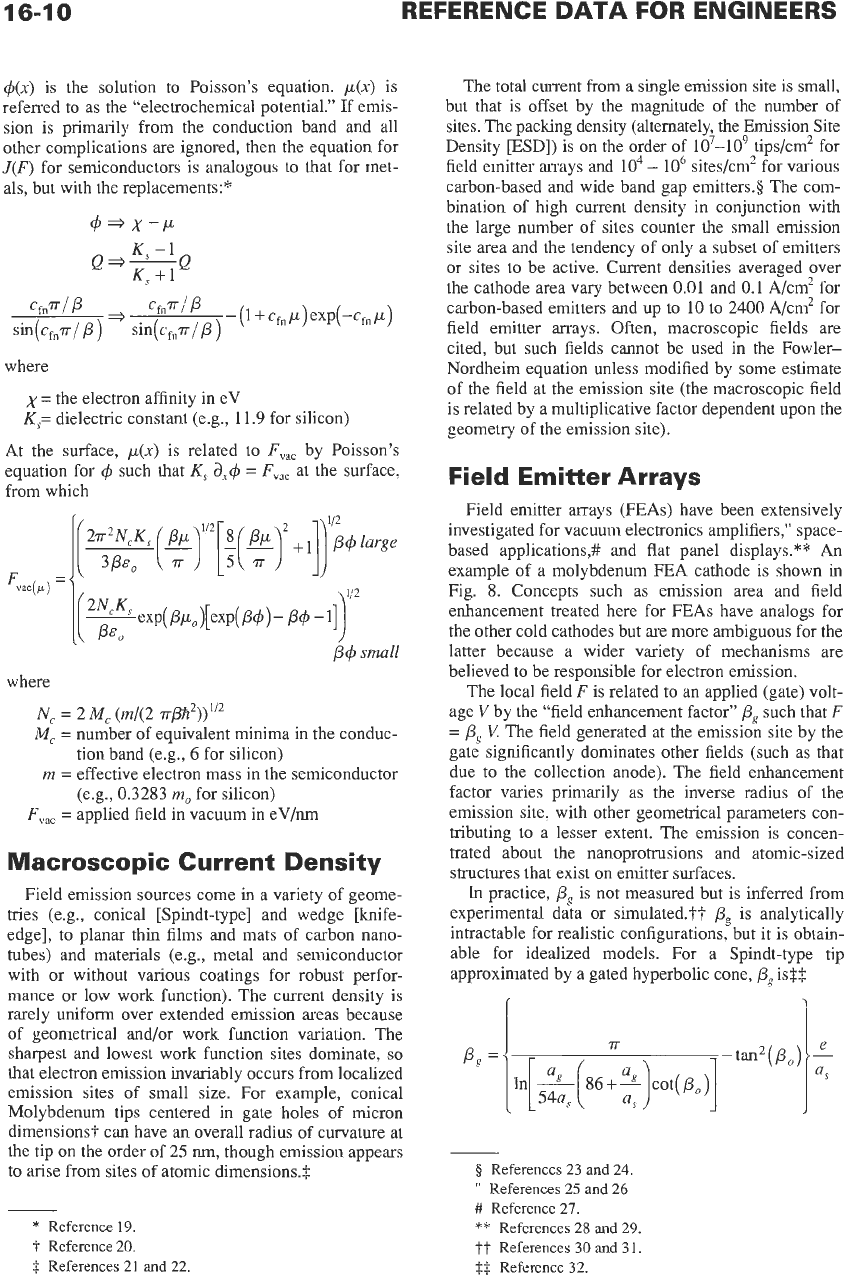
16-1
0
REFERENCE
DATA
FOR
ENGINEERS
+(x)
is the solution to Poisson’s equation.
p(x)
is
referred to as the “electrochemical potential.” If emis-
sion is primarily from the conduction band and all
other complications are ignored, then
the
equation for
J(F)
for semiconductors is analogous
to
that for met-
als, but with the replacements:*
+*X-P
Q
K,
-1
where
x
=
the electron affinity in eV
K,=
dielectric constant (e.g., 11.9 for silicon)
At the surface,
p(x)
is related to
F,,,
by Poisson’s
equation for
+
such that
K,
&+
=
F,,
at the surface,
from which
where
N,
=
2
M,
(m/(2
~p?))“~
M,
=
number of equivalent minima in
the
conduc-
m
=
effective electron mass in the semiconductor
tion band (e.g.,
6
for silicon)
(e.g., 0.3283
m,
for silicon)
F,,
=
applied field in vacuum in eV/nm
Macroscopic Current Density
Field emission sources come
in
a variety of geome-
tries (e.g., conical [Spindt-type] and wedge [knife-
edge], to planar thin films and mats of carbon nano-
tubes) and materials (e.g., metal and semiconductor
with or without various coatings for robust perfor-
mance or low work function). The current density
is
rarely uniform over extended emission areas because
of geometrical and/or work function variation. The
sharpest and lowest work function sites dominate,
so
that electron emission invariably occurs from localized
emission sites of small size. For example, conical
Molybdenum tips centered in gate holes of micron
dimensionst can have
an
overall radius of curvature at
the tip
on
the order of
25
nm,
though emission appears
to
arise from sites of atomic dimensions.$
*
Reference
19.
t
Reference 20.
$
References 21
and
22
The total current from a single emission site is small,
but that is offset by the magnitude of
the
number of
sites. The packing density (alternately, the Emission Site
Density [ESD]) is on the order of 107-109 tips/cm2 for
field emitter arrays and
lo4
-
lo6
sites/cm2 for various
carbon-based and wide band gap emitters.§ The com-
bination of high current density
in
conjunction with
the large number of sites counter the small emission
site area and the tendency of only a subset of emitters
or sites to be active. Current densities averaged over
the cathode area vary between 0.01 and
0.1
A/cm’ for
carbon-based emitters and up
to
10
to
2400 A/cm2 for
field emitter arrays. Often, macroscopic fields are
cited, but such fields cannot be used in the Fowler-
Nordheim equation unless modified by some estimate
of the field at the emission site (the macroscopic field
is related by a multiplicative factor dependent upon the
geometry of the emission site).
Field Emitter Arrays
Field emitter arrays
(FEAs)
have been extensively
investigated for vacuum electronics amplifiers,” space-
based applications,# and flat panel displays.**
An
example of a molybdenum
FEA
cathode is shown
in
Fig.
8.
Concepts such as emission area and field
enhancement treated here for FEAs have analogs for
the other cold cathodes but are more ambiguous for the
latter because a wider variety of mechanisms are
believed to be responsible for electron emission.
The local field
F
is related to an applied (gate) volt-
age
V
by the “field enhancement factor”
p,
such that
F
=
P,
V.
The field generated at the emission site by the
gate significantly dominates other fields (such as that
due to the collection anode). The field enhancement
factor varies primarily as the inverse radius
of
the
emission site, with other geometrical parameters con-
tributing
to
a lesser extent.
The
emission is concen-
trated about the nanoprohusions and atomic-sized
structures that exist on emitter surfaces.
In
practice,
P,
is not measured but
is
inferred from
experimental data or simulated.??
P,
is analytically
intractable for realistic configurations, but it is obtain-
able for idealized models. For a Spindt-type tip
approximated by a gated hyperbolic cone,
P,.
is$$
5
References 23 and
24.
”
References 25
and
26
#
Reference 27.
**
References
28
and 29.
tt
References
30
and
3
1.
$$
Reference
32.
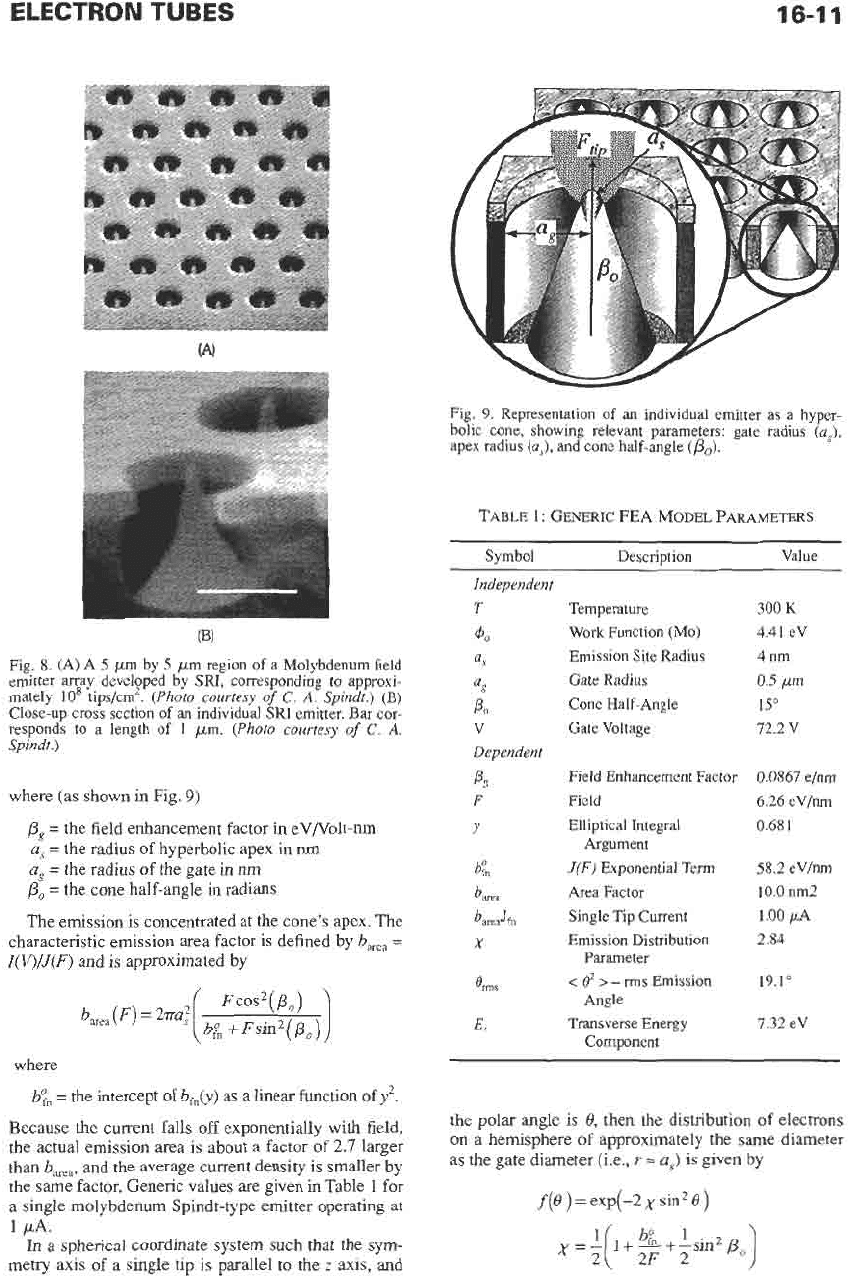
ELECTRON
TUBES
16-1
1
(B)
Fig. 8.
(A)
A
5
pm
by
5
pm
region
of
a Molybdenum field
emitter
array
developed by
SRI,
corresponding to approxi-
mately
lo8
tips/cm2.
(Photo courtesy
of
C.
A.
Spindt.)
(B)
Close-up cross section
of
an
individual SRI emitter.
Bar
cor-
responds to a length
of
1
pm. (Photo
courtesy
of
C.
A.
Spindt.)
where (as shown in Fig.
9)
Pg
=
the field enhancement factor
in
eV/Volt-nm
a,
=
the radius of hyperbolic apex in
nm
as
=
the radius of the gate in
nm
Po
=
the cone half-angle in radians
The emission
is
concentrated at the cone's apex. The
characteristic emission area factor is defined by
b,,,
=
Z(V)/J(F)
and is approximated by
where
b:,,
=
the intercept of
b,b)
as a linear function ofy2.
Because
the
current falls
off
exponentially with field,
the actual emission area is about a factor of
2.7
larger
than
b,,,
and the average current density is smaller by
the
same factor. Generic values are given in Table
1
for
a single molybdenum Spindt-type emitter operating at
1
PA.
In
a spherical coordinate system such that the sym-
metry axis
of
a single tip is parallel to the
z
axis, and
Fig.
9.
Representation of an individual emitter as a hyper-
bolic cone, showing relevant parameters: gate radius
(uJ,
apex radius (us), and cone half-angle
(Po).
TABLE
1
:
GENERIC FEA MODEL
PARAMETERS
Symbol Description Value
Temperature
Work
Function (Mo)
Emission Site Radius
Gate Radius
Cone Half-Angle
Gate Voltage
Field Enhancement Factor
Field
Elliptical Integral
Argument
J(F)
Exponential Term
Area Factor
Single Tip Current
Emission Distribution
<
8
>
-
rms Emission
Transverse Energy
Parameter
Angle
Component
300
K
4.41
eV
4
nm
0.5
pm
15"
72.2 V
0.0867
elnm
6.26
eV/nm
0.68
1
58.2 eVInm
10.0
nm2
1.00
pA
2.84
19.1"
7.32
eV
the polar angle is
0,
then the distribution
of
electrons
on
a hemisphere of approximately the same diameter
as
the gate diameter (i.e.,
r
=
as)
is
given by
f(e
)
=
exp(-2
x
sinZ
e
)
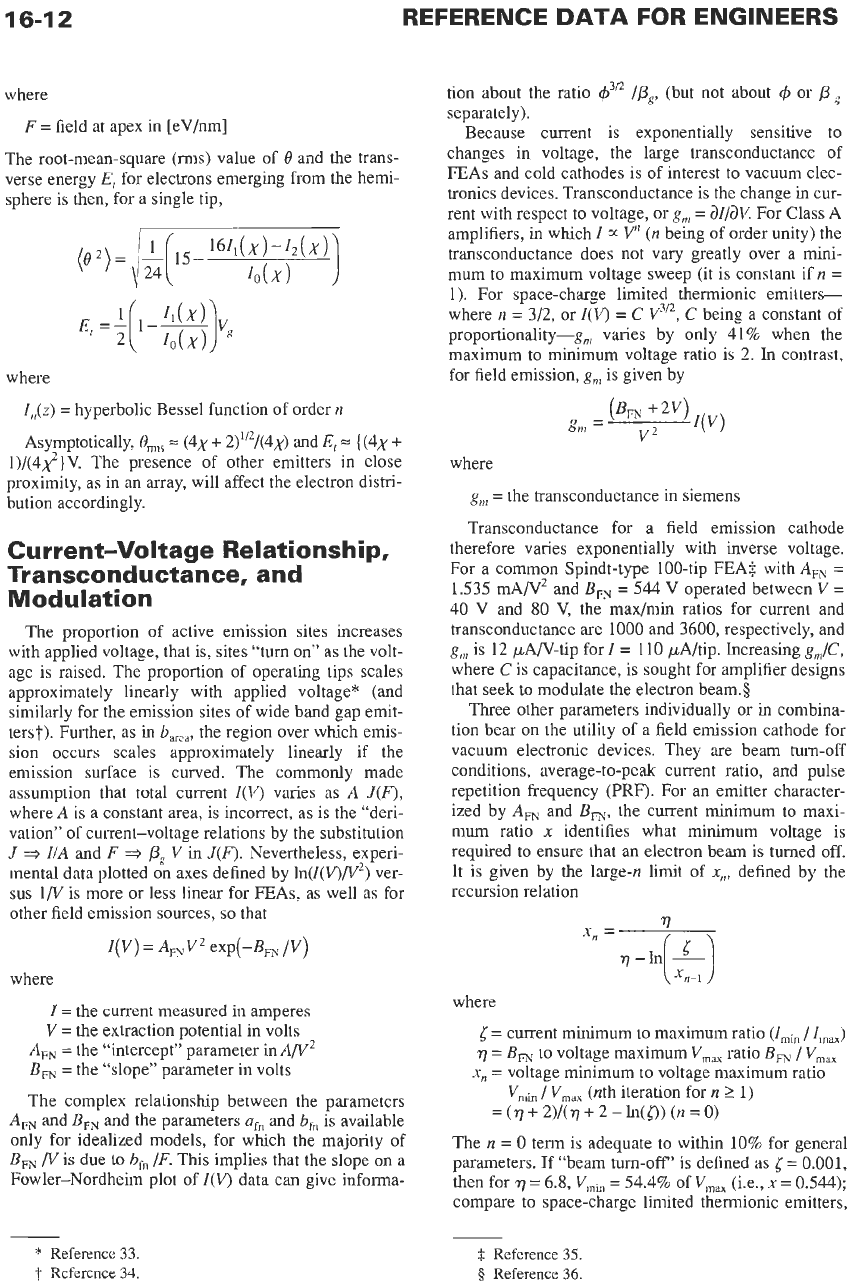
16-1
2
REFERENCE
DATA
FOR ENGINEERS
where
F
=
field at apex in [eV/nm]
The root-mean-square (rms) value of
8
and the trans-
verse energy
E,
for electrons emerging from the hemi-
sphere is then, for a single tip,
where
IJz)
=
hyperbolic Bessel function of order
n
Asymptotically,
e,,
=
(4x
+
2)’”/(4x)
and
E,
c- {
(4x
+
1)/(42]V.
The presence of other emitters in close
proximity, as in an array, will affect the electron distri-
bution accordingly.
Current-Voltage Relationship,
Transconductance, and
Modulation
The proportion of active emission sites increases
with applied voltage, that is, sites “turn on” as the volt-
age is raised. The proportion of operating tips scales
approximately linearly with applied voltage* (and
similarly for the emission sites of wide band gap emit-
terst). Further, as
in
b,,,,,
the region over which emis-
sion occurs scales approximately linearly if the
emission surface is curved. The commonly made
assumption that total current
I(V)
varies as
A
J(F),
where
A
is a constant area, is incorrect, as is the “deri-
vation” of current-voltage relations by the substitution
J
3
ZiA
and
F
+
p,
V
in
J(F).
Nevertheless, experi-
mental data plotted on axes defined by ln(Z(V)/Vz) ver-
sus
1/V
is
more or less linear for FEAs, as well as for
other field emission sources,
so
that
where
Z
=
the current measured in amperes
V
=
the extraction potential in volts
A,,
=
the “intercept” parameter inA/V2
B,
=
the “slope” parameter in volts
The complex relationship between the parameters
A,,
and B, and the parameters
afn
and
b,
is available
only for idealized models, for which the majority of
B,
/V
is due to
b,
/F.
This implies that the slope on a
Fowler-Nordheim plot
of
Z(V)
data can give informa-
tion about the ratio
c,b3I2
/&,
(but not about
c,b
or
p
separately).
Because current is exponentially sensitive
to
changes in voltage, the large transconductance of
FEAs and cold cathodes is of interest
to
vacuum elec-
tronics devices. Transconductance is the change in cur-
rent with respect to voltage, or
g,
=
aZ/&
For Class A
amplifiers,
in
which
I
V”
(n
being of order unity) the
transconductance does not vary greatly over a mini-
mum to maximum voltage sweep (it is constant if
n
=
1). For space-charge limited thermionic emitters-
where
n
=
3/2,
or
I(V)
=
C
V3I2,
C
being a constant of
proportionality-g, varies by only 41% when the
maximum to minimum voltage ratio is
2.
In
contrast,
for field emission,
g,
is given by
where
g,,
=
the transconductance in siemens
Transconductance for a field emission cathode
therefore varies exponentially with inverse voltage.
For a common Spindt-type 100-tip FEAS with
A,
=
1.535 mA/V2 and
B,
=
544
V
operated between
V
=
40
V and
80
V,
the max/min ratios for current and
transconductance are 1000 and 3600, respectively, and
g, is 12 PAR-tip for
I
=
110 pA/tip. Increasing
g,/C,
where
C
is capacitance, is sought for amplifier designs
that seek to modulate
the
electron beam.
§
Three other parameters individually or in combina-
tion bear on the utility of a field emission cathode for
vacuum electronic devices. They are beam
turn-off
conditions, average-to-peak current ratio, and pulse
repetition frequency
(PRF).
For an emitter character-
ized by
A,
and
B,,
the current minimum to maxi-
mum ratio
x
identifies what minimum voltage is
required
to
ensure that an electron beam
is
turned
off.
It is given by the large-n limit of
xn,
defined by the
recursion relation
where
5
=
current minimum
to
maximum ratio
(Imin
/
Zmm)
77
=
B,
to voltage maximum
V,,
ratio
B,
/
V,,,
x,
=
voltage minimum to voltage maximum ratio
Vmin
/
V,,
(nth iteration for
n
t
1)
=
(rl+
2)/(7J
+
2
-lncn,
(n
=
0)
The
n
=
0
term is adequate to within 10% for general
parameters. If “beam
turn-off’’
is defined as
<=
0.001,
then for
17
=
6.8,
V,,
=
54.4%
of
V,,
(i.e.,
x
=
0.544);
compare to space-charge limited thermionic emitters,
*
Reference 33.
t
Reference 34.
$.
Reference 35.
5
Reference 36.
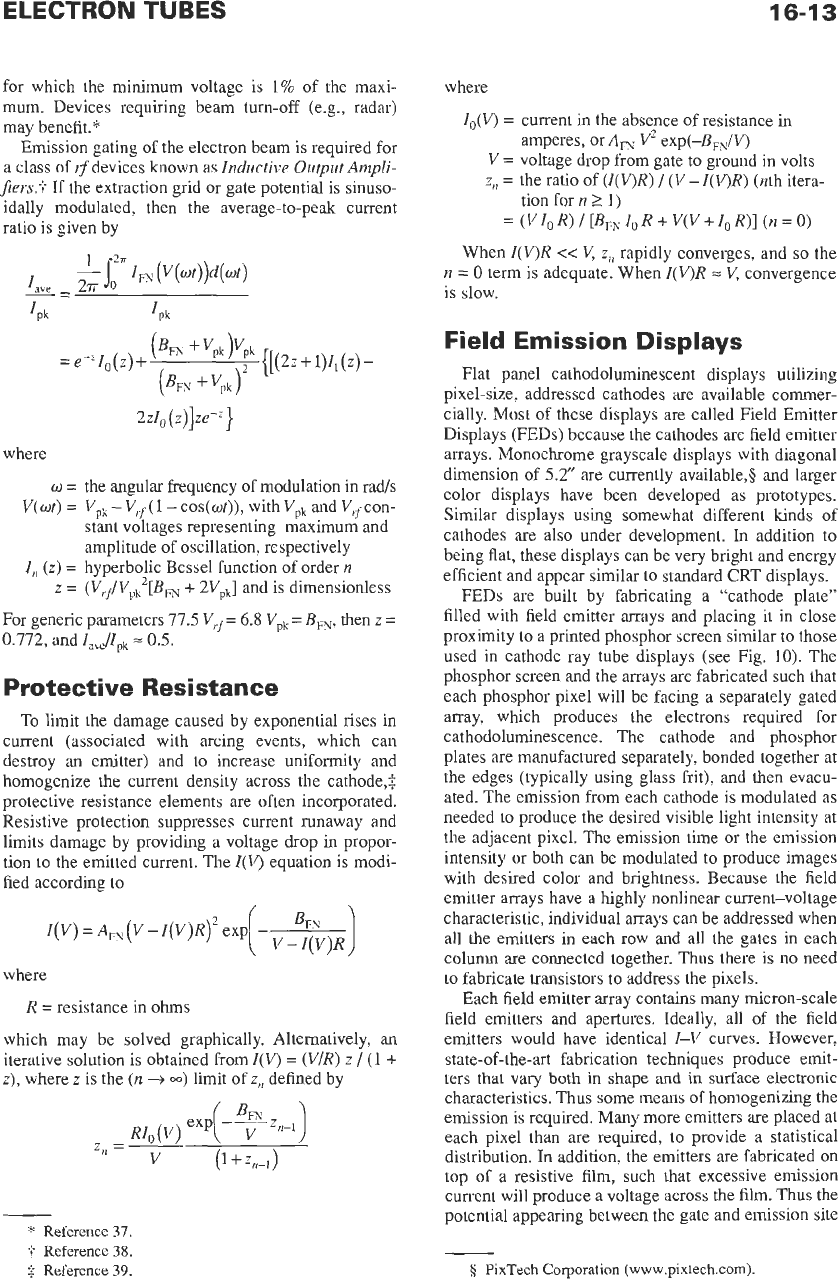
ELECTRON TUBES
16-13
for which the minimum voltage is
1%
of the maxi-
mum. Devices requiring beam turn-off (e.g., radar)
may benefit.
*
Emission gating of the electron beam is required for
a class of fldevices known as
Inductive
Output
Ampli-
fiers.?
If
the extraction grid or gate potential is sinuso-
idally modulated, then the average-to-peak current
ratio
is
given by
=
e-’I,(z)+
where
w
=
the angular frequency of modulation in rad/s
v(
Wt)
=
vpk
-
vrf
(
1
-
COS(
Wt)),
with
vpk
and
vi.
Con-
stant voltages representing maximum and
amplitude of oscillation, respectively
Z,
(z)
=
hyperbolic Bessel function of order
n
z
=
(Vrf/Vp,2[Bm
+
2Vpk] and is dimensionless
For generic parameters 77.5
Vrf
=
6.8
Vpk
=
B,,,
then
z
=
0.772, and
Iave/Ipk
=
0.5.
Protective Resistance
To limit the damage caused by exponential rises in
current (associated with arcing events, which can
destroy
an
emitter) and to increase uniformity and
homogenize the current density across the cathode,$
protective resistance elements
are
often incorporated.
Resistive protection suppresses current runaway and
limits damage by providing a voltage drop in propor-
tion to the emitted current. The
Z(V)
equation is modi-
fied according to
I(v)=A,(v-I(v)R)’~~~
[
-
VP,;.,,,)
where
R
=
resistance in
ohms
which may be solved graphically. Alternatively,
an
iterative solution is obtained from
I(V)
=
(VIR)
z
/
(1
+
z),
where
z
is the
(n
+
m)
limit
of
z, defined by
*
Reference
37.
t
Reference
38.
Reference
39.
where
I,(v)
=
current
in
the absence of resistance
in
amperes, or
A,
V2
exp(-B,/V)
V
=
voltage drop from gate to ground in volts
z,
=
the ratio of (I(V)R)
/
(V- I(V)R) (nth itera-
=
(V
Io
R)
/
[BFK
Io
R
+
V(V
+
Io
R)]
(n
=
0)
tion for
n
2
1)
When I(V)R
<<
r/;
z,
rapidly converges, and
so
the
n
=
0
term is adequate. When
I(V)R
r=-
V,
convergence
is slow.
Field Emission Displays
Flat panel cathodoluminescent displays utilizing
pixel-size, addressed cathodes are available commer-
cially. Most of these displays are called Field Emitter
Displays (FEDs) because the cathodes are field emitter
arrays. Monochrome grayscale displays with diagonal
dimension of 5.2“ are currently available,§ and larger
color displays have been developed as prototypes.
Similar displays using somewhat different kinds of
cathodes
are
also under development. In addition to
being flat, these displays can be very bright and energy
efficient and appear similar to standard CRT displays.
FEDs are built by fabricating a “cathode plate”
filled with field emitter arrays and placing it in close
proximity to a printed phosphor screen similar to those
used
in
cathode ray tube displays (see Fig.
10).
The
phosphor screen and the arrays are fabricated such that
each phosphor pixel will be facing a separately gated
array, which produces the electrons required for
cathodoluminescence. The cathode and phosphor
plates are manufactured separately, bonded together at
the edges (typically using glass frit), and then evacu-
ated. The emission from each cathode is modulated as
needed to produce the desired visible light intensity at
the adjacent pixel. The emission time or the emission
intensity or both can be modulated to produce images
with desired color and brightness. Because the field
emitter arrays have a highly nonlinear current-voltage
characteristic, individual arrays
can
be addressed when
all the emitters in each row and all the gates in each
column are connected together. Thus there is no need
to fabricate transistors to address the pixels.
Each field emitter array contains many micron-scale
field emitters and apertures. Ideally, all of the field
emitters would have identical
I-V
curves. However,
state-of-the-art fabrication techniques produce emit-
ters that vary both
in
shape and in surface electronic
characteristics. Thus some means
of
homogenizing the
emission is required. Many more emitters are placed at
each pixel than
are
required, to provide a statistical
distribution. In addition, the emitters are fabricated on
top of a resistive film, such that excessive emission
current will produce a voltage across the film. Thus the
potential appearing between the gate and emission site
§
PixTech
Corporation
(www.pixtech.com)
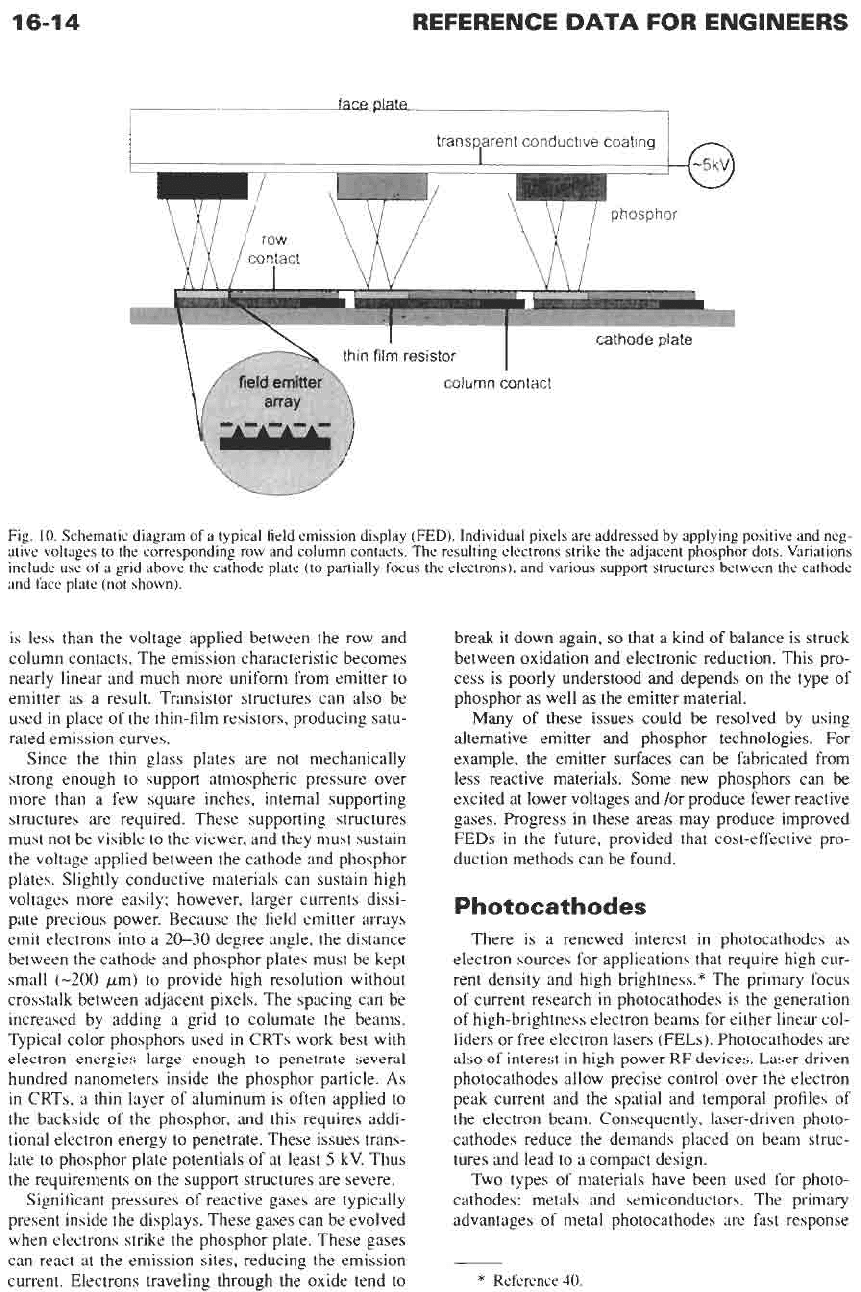
16-14
REFERENCE
DATA
FOR ENGINEERS
transpfirent
conductive
coating
-
I
,-a-
\
column
contact
\
Fig.
10.
Schematic diagram
of
a typical field emission display
(FED).
Individual pixels
are
addressed
by
applying positive and neg-
ative voltages to the corresponding row
and
column contacts. The resulting electrons strike the adjacent phosphor dots. Variations
include
use
of
a
grid
above
the
cathode plate
(to
partially
focus
the electrons), and various
support
structures between the
cathode
and
face plate (not shown).
is less than
the
voltage applied between
the
row and
column contacts. The emission characteristic becomes
nearly linear and much more uniform from emitter to
emitter as a result. Transistor structures can also
be
used in place of the thin-film resistors, producing satu-
rated emission curves.
Since the thin glass plates
are
not mechanically
strong enough to support atmospheric pressure over
more than a few square inches, internal supporting
structures are required. These supporting structures
must not be visible to the viewer, and they must sustain
the voltage applied between the cathode and phosphor
plates. Slightly conductive materials can sustain high
voltages more easily; however, larger currents dissi-
pate precious power. Because the field emitter arrays
emit electrons into a
20-30
degree angle, the distance
between the cathode and phosphor plates must
be
kept
small
(-200
pm)
to provide high resolution without
crosstalk between adjacent pixels. The spacing can be
increased by adding a grid to columate the beams.
mica1 color phosphors used in CRTs work best with
electron energies large enough to penetrate several
hundred nanometers inside the phosphor particle.
As
in CRTs, a thin layer of aluminum is often applied to
the backside of the phosphor, and this requires addi-
tional electron energy to penetrate. These issues trans-
late to phosphor plate potentials
of
at least
5
kV. Thus
the requirements on the support structures
are
severe.
Significant pressures of reactive gases are typically
present inside the displays. These. gases can
be
evolved
when electrons strike the phosphor plate.
These
gases
can react at the emission sites, reducing the emission
current. Electrons traveling through the oxide tend to
break
it down again,
so
that a kind
of
balance is struck
between oxidation and electronic reduction.
This
pro-
cess
is
poorly understood and depends on the
type
of
phosphor as well
as
the emitter material.
Many of
these
issues could be resolved by using
alternative emitter and phosphor technologies. For
example,
the
emitter surfaces can
be
fabricated from
less reactive materials. Some new phosphors can
be
excited at lower voltages and
/or
produce fewer reactive
gases.
Progress
in these
areas
may produce improved
FFiDs
in
the
future, provided that cost-effective pro-
duction methods can
be
found.
Photocathodes
There
is
a renewed interest in photocathodes as
electron sources for applications that require high cur-
rent density and high brightness.* The primary focus
of current research in photocathodes is the generation
of high-brightness electron beams for either linear col-
liders or free electron lasers
(FELs).
Photocathodes
are
also of interest in high-power RF devices. Laser-driven
photocathodes allow precise control over the electron
peak
current and
the
spatial and temporal profiles of
the electron beam. Consequently, laser-driven photo-
cathodes reduce
the
demands placed on beam struc-
tures and lead to a compact design.
Two
types of materials have been used for photo-
cathodes: metals and semiconductors. The primary
advantages of metal photocathodes
are
fast response
*
Reference
40.
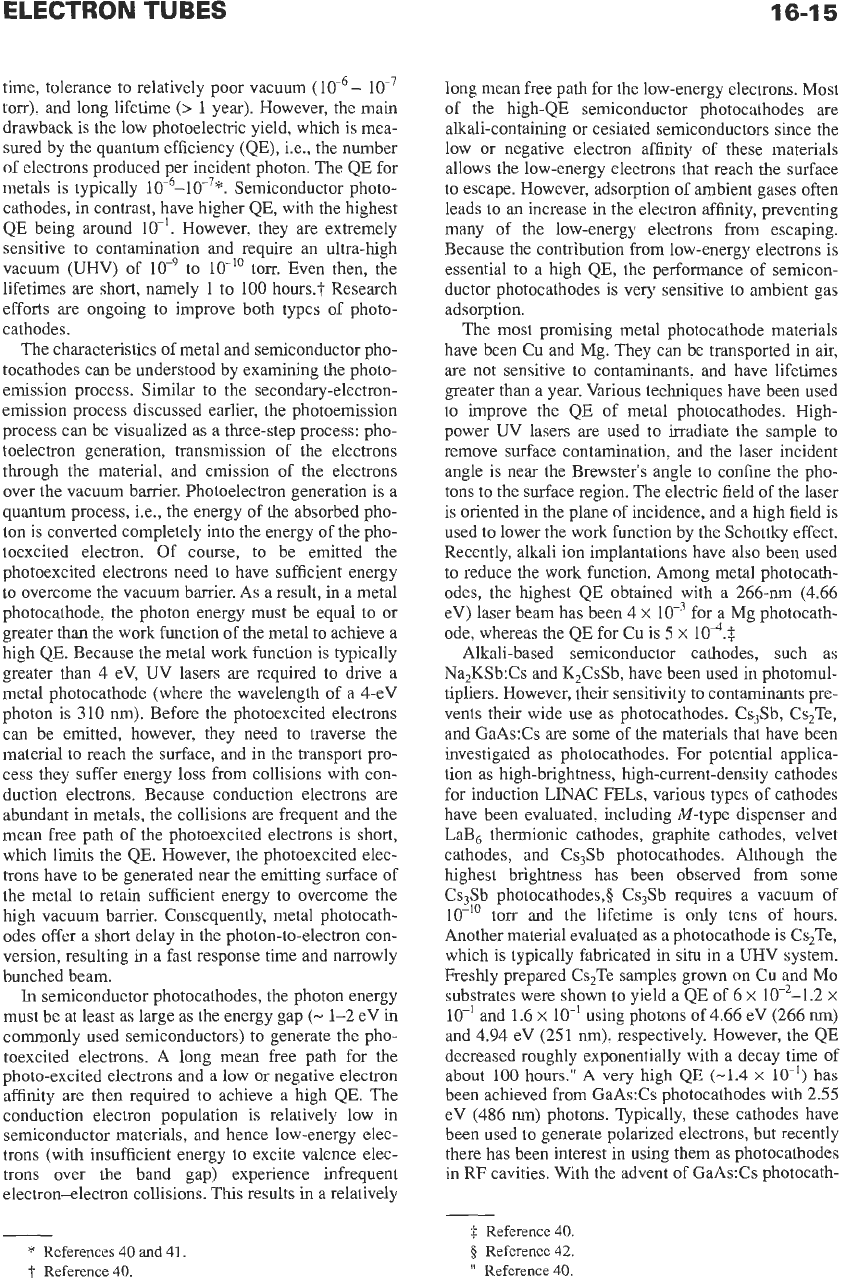
ELECTRON
TUBES
16-1
5
time, tolerance to relatively poor vacuum
-
10"
torr), and long lifetime
(>
1
year). However, the main
drawback is the low photoelectric yield, which is mea-
sured by the quantum efficiency (QE), i.e., the number
of electrons produced per incident photon. The QE for
metals is typically 10-6-10-7*. Semiconductor photo-
cathodes, in contrast, have higher QE, with the highest
QE being around
lo-'.
However, they are extremely
sensitive to contamination and require an ultra-high
vacuum (UHV) of to
lo-''
tom. Even then, the
lifetimes are short, namely
1
to
100
hours.? Research
efforts are ongoing to improve both types of photo-
cathodes.
The characteristics of metal and semiconductor pho-
tocathodes can be understood by examining the photo-
emission process. Similar to the secondary-electron-
emission process discussed earlier, the photoemission
process can be visualized as a three-step process: pho-
toelectron generation, transmission of the electrons
through the material, and emission of the electrons
over the vacuum barrier. Photoelectron generation is a
quantum process, i.e., the energy of the absorbed pho-
ton is converted completely into the energy of the pho-
toexcited electron. Of course, to be emitted the
photoexcited electrons need
to
have sufficient energy
to
overcome the vacuum barrier. As a result, in a metal
photocathode, the photon energy must be equal to or
greater than the work function of the metal to achieve a
high QE. Because the metal work function is typically
greater than 4 eV, UV lasers
are
required to drive a
metal photocathode (where the wavelength of a 4-eV
photon is
3
10
nm). Before the photoexcited electrons
can be emitted, however, they need to traverse the
material to reach the surface, and in the transport pro-
cess they suffer energy loss from collisions with con-
duction electrons. Because conduction electrons are
abundant in metals, the collisions are frequent and the
mean free path
of
the photoexcited electrons is short,
which limits the QE. However, the photoexcited elec-
trons have
to
be generated near the emitting surface of
the metal to retain sufficient energy
to
overcome the
high vacuum barrier. Consequently, metal photocath-
odes offer a short delay
in
the photon-to-electron con-
version, resulting
in
a fast response time and narrowly
bunched beam.
In
semiconductor photocathodes, the photon energy
must be at least as large as the energy gap
(-
1-2 eV
in
commonly used semiconductors) to generate the pho-
toexcited electrons. A long mean free path for the
photo-excited electrons and a
low
or negative electron
affinity are then required
to
achieve a high QE. The
conduction electron population is relatively low in
semiconductor materials, and hence low-energy elec-
trons (with insufficient energy
to
excite valence elec-
trons over the band gap) experience infrequent
electron-electron collisions.
This
results
in
a relatively
long mean free path for the low-energy electrons. Most
of
the high-QE semiconductor photocathodes
are
alkali-containing or cesiated semiconductors since the
low or negative electron affinity of these materials
allows the low-energy electrons that reach the surface
to escape. However, adsorption of ambient gases often
leads to an increase in the electron affinity, preventing
many of the low-energy electrons from escaping.
Because the contribution from low-energy electrons is
essential
to
a high QE, the performance of semicon-
ductor photocathodes is very sensitive
to
ambient gas
adsorption.
The most promising metal photocathode materials
have been Cu and Mg. They can be transported in air,
are not sensitive to contaminants, and have lifetimes
greater than a year. Various techniques have been used
to
improve the QE of metal photocathodes. High-
power UV lasers
are
used to irradiate the sample to
remove surface contamination, and the laser incident
angle is near the Brewster's angle
to
confine the pho-
tons to the surface region. The electric field of the laser
is oriented
in
the plane of incidence, and a high field is
used to lower the work function by the Schottky effect.
Recently, alkali ion implantations have also been used
to reduce the work function. Among metal photocath-
odes, the highest QE obtained with a 266-nm (4.66
eV) laser beam has been 4
x
for a Mg photocath-
ode, whereas the QE for Cu is
5
x
lo4.$
Alkali-based semiconductor cathodes, such as
Na,KSb:Cs and K,CsSb, have been used in photomul-
tipliers. However, their sensitivity to contaminants pre-
vents their wide use as photocathodes. Cs,Sb, Cs,Te,
and GaAs:Cs
are
some of the materials that have been
investigated as photocathodes. For potential applica-
tion as high-brightness, high-current-density cathodes
for induction LINAC
FELs,
various types of cathodes
have been evaluated, including M-type dispenser and
LaB, thermionic cathodes, graphite cathodes, velvet
cathodes, and Cs3Sb photocathodes. Although the
highest brightness has been observed from some
Cs,Sb photocathodes,§ Cs3Sb requires a vacuum of
lo-''
torr and the lifetime is only tens of hours.
Another material evaluated as a photocathode is Cs,Te,
which is typically fabricated
in
situ in a UHV system.
Freshly prepared Cs,Te samples grown on Cu and Mo
substrates were shown to yield a QE of 6
x
10-,-1.2
x
lo-'
and 1.6
x lo-'
using photons of 4.66 eV (266
nm)
and 4.94 eV (251 nm), respectively. However, the QE
decreased roughly exponentially with a decay time of
about 100 hours."
A
very high
QE
(-1.4
x
lo-')
has
been achieved from
GaAs:Cs
photocathodes with 2.55
eV (486
nm)
photons. Typically, these cathodes have
been used
to
generate polarized electrons, but recently
there has been interest in using them as photocathodes
in
RF
cavities. With the advent
of
GaAs:Cs photocath-
*
References 40
and
41
t
Reference 40.
$
Reference
40.
3
Reference
42.
"
Reference 40.
